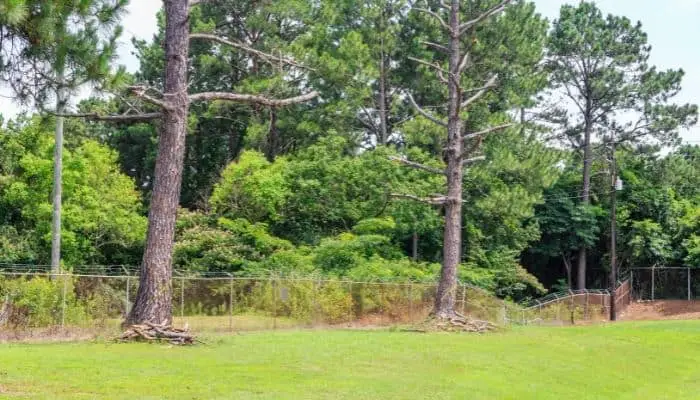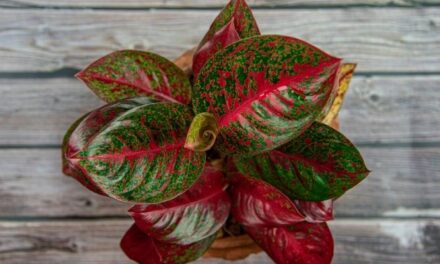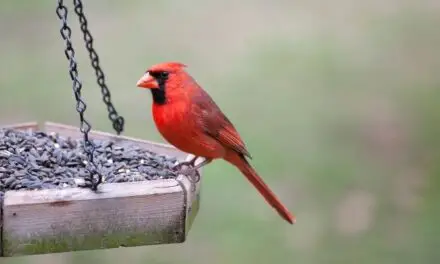Weighing in at an average of five and a half thousand pounds, a dead pine tree standing precariously on your property can be a serious situation – especially if it’s a threat to your or your neighbor’s property.
In this article, we’re going to talk about how to identify a dead or dying pine tree and how you should deal with it.
Table of Contents
Are Dead Pine Trees Dangerous?

Yes, dead pine trees are dangerous, and the longer they’re left standing the more at risk they are of falling.
In addition to random branches falling off and causing injury or damage, the whole tree could come down and seriously hurt or kill somebody.
You should get a quote from an arborist and get the tree cut down as soon as possible.
If you think the dead pine tree is at risk of falling on your house or causing damage to your property, you should contact your insurance company first and let them know of the potential hazard.
They will instruct you on the next steps to take.
How To Tell If A Pine Tree Is Dead?
Peeling bark, browning needles, and needles being shed before the end of summer are all signs that things are not well with your pine tree.
In addition, if you see dead or dying branches with scattered bark and the tree beginning to lean over to one side; these are strong indications that the pine tree is dying or already dead.
You can also remove some of the dry, outer layer of bark to expose the tree’s green cambium bark layer.
If you find that the cambium layer is dry and brown, then the tree may be dead already.
You can also take a look at the lower branches.
When you put pressure on the branch it should have a bit of a spring to it.
If it feels brittle and snaps real easy then it’s probably a dead branch and a sign that the tree itself is dying or dead.
How Long Will A Dead Pine Tree Stand?
Unfortunately, there’s no way to predict exactly how long a dead pine tree will remain standing for.
It could possibly fall in as soon as a few days, a couple of years, or it could even last for decades.
It may also be the next bit of extreme weather that will see it come crashing to the ground; it could be the next storm or a build-up of snow.
There is no exact way to tell when a dead pine tree may fall, so if you have one on your property that could potentially do damage, it’s best to get it dealt with sooner rather than later.
You Might Also Like: Is Growing Vegetables Near Trees a Good Idea?
Should I Remove My Dead Pine Tree?
Yes, you should get your dead pine tree removed as soon as possible but do not attempt to do it yourself unless you are a professional.
Contact an arborist for a quote (should be free) and to come and take a look at your tree and to see what the risk is for it falling over.
If there’s a storm or the tree just falls on its own and hurts somebody or damages your neighbor’s property, you could find yourself liable.
If it was found that you knew the tree was a danger and didn’t do anything, you’d likely be pursued for damages.
Can I Cut Down A Dead Pine Tree On My Own?
Unless you are a professional, you should not attempt to cut down a dead pine tree on your own.
Many things can go wrong and if you don’t make the cuts in the base of the tree precisely, there is no telling where or how the tree may fall.
Cutting The Notch
A professional will cut a 70-degree notch out of the base of the tree, acting like a hinge, the notch will guide the tree to fall in a certain direction (the opposite one to your house!).
If you cut this notch incorrectly and do not account for how the tree is leaning, there is no telling which way it will come down.
The Boring Cut
Once the notch is precisely cut, a boring cut would need to be made directly into the base of the tree.
The boring cut must also be precisely lined up with the notch that was cut from the tree earlier.
Wedges
If the tree is leaning the wrong way, wedges will have to be hammered in to force the tree to fall in the opposite direction.
Once the boring cut is made and depending on how the tree is leaning, wedges may have to be hammered into the sides of the tree to ensure it falls the way you need it to.
At this point, there is only a small sliver of wood supporting the tree.
Over She Goes
Once the final cut is made and the wedges are hammered in, the tree should begin to lean and fall in the desired direction.
Doing this without having a ton of experience is highly dangerous and there are a lot of things that could go wrong.
The tree could fall on top of you or someone else, it could fall on your house, or it could split in half while falling to the ground and catch you completely off guard.
How Much Does It Cost To Have A Dead Pine Tree Removed?
The cost of cutting down an average-sized pine tree shouldn’t be any more than a couple of hundred dollars.
Get a couple of quotes from arborists first (which should be free) to see if there are any savings to be had.
If you decide to leave your dead pine tree to chance and it falls on a neighbor or their house, you may be looking at a far bigger bill than a couple of hundred dollars.
What Kills Pine Trees?
Pine trees can potentially live for thousands of years but often have their lives cut short due to disease and pest infestations.
Here are a few of the most common:
Pine Bark Beetles
These pests attack trees during periods of drought.
Pine bark beetles burrow into the tree during the spring and lay eggs beneath its bark.
The hatched larvae then tunnel through the bark as they feed, disrupting the tree’s access to nutrients and water.
Some symptoms of a pine bark beetle infestation are brown dust from the borrowing insects, accumulation of resin on the surface of the tree, and the presence of pitch tubes.
Bad infestations are usually untreatable, resulting in the pine tree having to be cut down.
Pine Wilt
The pine wilt nematode causes a pine tree to wilt by blocking its resin canals and restricting access to nutrients and water.
Some symptoms of pine wilt are brown droopy needles and a lack of sap leakage.
Pine wilt is usually untreatable and can kill a tree within a matter of weeks.
Needle Blight Disease
Caused by a type of fungus called Dothistroma pini.
Needle blight affects a wide range of pine trees, causing needles to turn brown, die, and fall off.
Infections usually begin in the lower branches of the tree and then spread throughout.
If caught early, an application of copper fungicide can be used to control needle blight disease.
Final Thoughts
A dead pine tree on your property can be a real pain and it can be tempting to just leave it be.
But that may be a decision you will live to regret.
Assess the situation for potential risk of injury and damage to property and if possible, have the tree removed.
It shouldn’t cost more than around $200 to get the tree cut down.
But if you really can’t afford it, at least try to limit access and have it assessed by an expert to try and determine how much longer it will stay standing.




